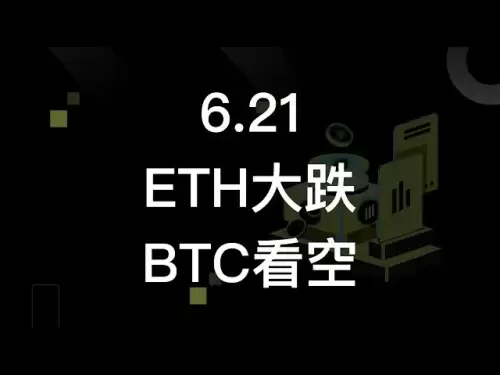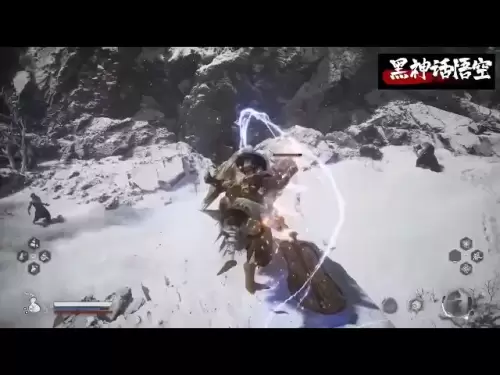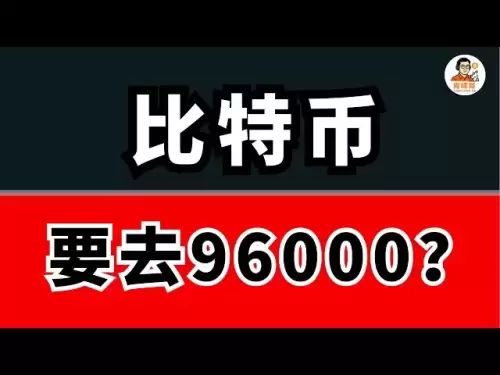-
 Bitcoin
Bitcoin $106,754.6083
1.33% -
 Ethereum
Ethereum $2,625.8249
3.80% -
 Tether USDt
Tether USDt $1.0001
-0.03% -
 XRP
XRP $2.1891
1.67% -
 BNB
BNB $654.5220
0.66% -
 Solana
Solana $156.9428
7.28% -
 USDC
USDC $0.9998
0.00% -
 Dogecoin
Dogecoin $0.1780
1.14% -
 TRON
TRON $0.2706
-0.16% -
 Cardano
Cardano $0.6470
2.77% -
 Hyperliquid
Hyperliquid $44.6467
10.24% -
 Sui
Sui $3.1128
3.86% -
 Bitcoin Cash
Bitcoin Cash $455.7646
3.00% -
 Chainlink
Chainlink $13.6858
4.08% -
 UNUS SED LEO
UNUS SED LEO $9.2682
0.21% -
 Avalanche
Avalanche $19.7433
3.79% -
 Stellar
Stellar $0.2616
1.64% -
 Toncoin
Toncoin $3.0222
2.19% -
 Shiba Inu
Shiba Inu $0.0...01220
1.49% -
 Hedera
Hedera $0.1580
2.75% -
 Litecoin
Litecoin $87.4964
2.29% -
 Polkadot
Polkadot $3.8958
3.05% -
 Ethena USDe
Ethena USDe $1.0000
-0.04% -
 Monero
Monero $317.2263
0.26% -
 Bitget Token
Bitget Token $4.5985
1.68% -
 Dai
Dai $0.9999
0.00% -
 Pepe
Pepe $0.0...01140
2.44% -
 Uniswap
Uniswap $7.6065
5.29% -
 Pi
Pi $0.6042
-2.00% -
 Aave
Aave $289.6343
6.02%
Is VWAP accurate in a flag pattern? What are the key points of volume coordination?
VWAP can be accurate in flag patterns if calculated over the flag's formation period, aiding traders in assessing trade efficiency and potential breakouts.
May 28, 2025 at 11:28 pm
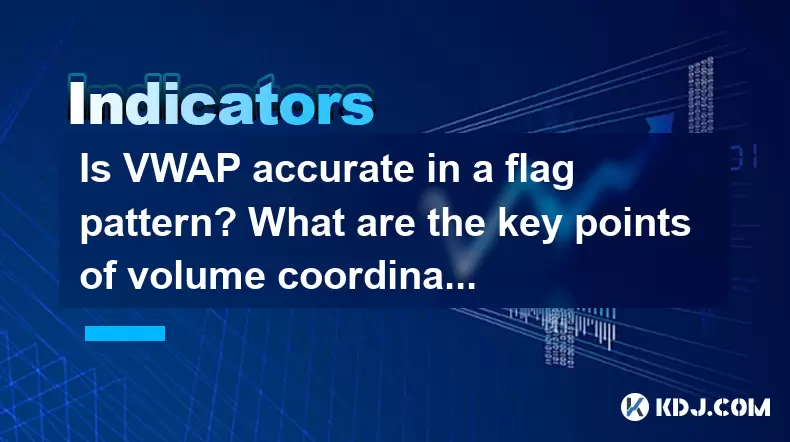
The Volume Weighted Average Price (VWAP) is a trading benchmark used by traders to gauge the average price at which a cryptocurrency has traded throughout the day, weighted by volume. It is particularly useful in assessing the efficiency of trade executions and can be an essential tool in the analysis of various chart patterns, such as the flag pattern. In this article, we will explore whether VWAP is accurate in a flag pattern and delve into the key points of volume coordination that traders should consider.
Understanding VWAP and Flag Patterns
VWAP is calculated by taking the total dollar amount of all trades and dividing it by the total trading volume for the period. The formula is as follows:
[ \text{VWAP} = \frac{\sum (\text{Price} \times \text{Volume})}{\sum \text{Volume}} ]
A flag pattern is a continuation pattern that appears as a small rectangular shape, known as the "flag," which follows a sharp price movement, known as the "pole." The flag pattern typically indicates that the market is taking a brief pause before continuing in the direction of the initial trend.
Accuracy of VWAP in Flag Patterns
The accuracy of VWAP in a flag pattern can be influenced by several factors, including the timeframe used for the VWAP calculation and the volume dynamics within the pattern itself. When the VWAP is calculated over a period that closely aligns with the formation of the flag pattern, it can provide a more accurate representation of the average price during that consolidation phase.
Traders often use VWAP to determine potential entry and exit points within a flag pattern. If the price is trading above the VWAP, it may indicate bullish sentiment, suggesting that the breakout from the flag could be to the upside. Conversely, if the price is trading below the VWAP, it may suggest bearish sentiment, indicating a potential downside breakout.
Key Points of Volume Coordination in Flag Patterns
Volume coordination is crucial in analyzing flag patterns, as it can provide insights into the strength and potential direction of the breakout. Here are some key points to consider:
- Volume during the Pole Formation: The initial sharp move that forms the pole should be accompanied by high volume. This indicates strong interest and conviction in the direction of the move.
- Volume during the Flag Consolidation: During the flag formation, volume typically decreases. This decrease in volume suggests that the market is taking a breather before the next move. However, if the volume remains high during the flag, it could signal that the consolidation phase might be short-lived.
- Volume at Breakout: The volume at the breakout from the flag is critical. A breakout accompanied by a significant increase in volume is more likely to result in a sustained move in the direction of the breakout. Conversely, a breakout with low volume may indicate a false breakout.
Using VWAP and Volume Coordination Together
Combining VWAP with volume coordination can enhance a trader's ability to make informed decisions within a flag pattern. Here’s how traders can use these tools together:
- Monitoring VWAP during the Flag: As the price consolidates within the flag, traders can monitor how the price interacts with the VWAP. If the price consistently stays above the VWAP, it may reinforce a bullish bias. If the price remains below the VWAP, it may reinforce a bearish bias.
- Volume Confirmation at Breakout: When the price breaks out of the flag, traders should look for confirmation from volume. If the breakout occurs with high volume and the price moves away from the VWAP in the direction of the breakout, it can provide a strong signal for entry.
- Re-entry Points: If the price pulls back to the VWAP after a breakout, it can serve as a potential re-entry point for traders who missed the initial move. The volume during this pullback can provide additional confirmation of the strength of the trend.
Practical Application of VWAP and Volume Coordination
Let's walk through a hypothetical example of how a trader might use VWAP and volume coordination within a flag pattern:
- Identify the Flag Pattern: First, the trader identifies a flag pattern on the chart, noting the pole and the subsequent consolidation phase.
- Calculate VWAP: The trader calculates the VWAP over the period of the flag pattern. This can be done using trading software or manually if necessary.
- Monitor Price and VWAP: The trader observes the price action within the flag, noting whether the price stays above or below the VWAP.
- Watch Volume: The trader monitors the volume during the pole formation, the flag consolidation, and at the breakout.
- Breakout Confirmation: If the price breaks out of the flag with high volume and moves away from the VWAP in the direction of the breakout, the trader may consider entering a position.
- Re-entry Opportunities: If the price pulls back to the VWAP after the breakout, the trader can look for high volume during this pullback as a potential re-entry signal.
Potential Challenges and Considerations
While VWAP and volume coordination can be powerful tools, traders should be aware of potential challenges and considerations:
- Timeframe Sensitivity: The accuracy of VWAP can be sensitive to the chosen timeframe. A VWAP calculated over a shorter period may be more responsive to recent price movements but could also be more volatile.
- False Breakouts: Even with high volume, breakouts from flag patterns can sometimes be false. Traders should use additional technical indicators and risk management strategies to mitigate the impact of false breakouts.
- Market Conditions: The effectiveness of VWAP and volume coordination can vary depending on overall market conditions. In highly volatile markets, these tools may need to be adjusted to account for increased price swings and volume fluctuations.
Frequently Asked Questions
Q1: Can VWAP be used effectively in other chart patterns besides the flag pattern?
Yes, VWAP can be used effectively in various chart patterns, including triangles, wedges, and head and shoulders patterns. The key is to align the VWAP calculation period with the formation of the pattern to get an accurate average price during that period.
Q2: How can traders adjust their VWAP calculations for different timeframes?
Traders can adjust their VWAP calculations by changing the period over which the VWAP is calculated. For shorter-term trading, a VWAP calculated over a few minutes or hours may be more relevant. For longer-term analysis, a daily or weekly VWAP might be more appropriate.
Q3: What other indicators can be used alongside VWAP and volume to confirm breakouts?
Traders can use additional indicators such as the Relative Strength Index (RSI), Moving Average Convergence Divergence (MACD), and Bollinger Bands to confirm breakouts. These indicators can provide additional insights into momentum, trend strength, and potential overbought or oversold conditions.
Q4: How can traders manage risk when using VWAP and volume coordination in flag patterns?
Traders can manage risk by setting stop-loss orders below the breakout point for long positions and above the breakout point for short positions. Additionally, they can use position sizing strategies to limit the amount of capital at risk on any single trade.
Disclaimer:info@kdj.com
The information provided is not trading advice. kdj.com does not assume any responsibility for any investments made based on the information provided in this article. Cryptocurrencies are highly volatile and it is highly recommended that you invest with caution after thorough research!
If you believe that the content used on this website infringes your copyright, please contact us immediately (info@kdj.com) and we will delete it promptly.
- Pi Coin Price Bulls: Navigating the Crossroads After Mainnet Launch
- 2025-06-21 18:45:12
- ZachXBT, Bitcoin Bridges, and Garden Finance: A Deep Dive
- 2025-06-21 18:25:11
- BTC Recovery, Bearish Sentiment, and Trader Impatience: Navigating the Crypto Maze
- 2025-06-21 18:25:11
- SUI Price Wobbles Amid Crypto Slump: Opportunity or Omen?
- 2025-06-21 18:45:12
- Worldcoin Price Prediction: Will WLD Stage a Comeback?
- 2025-06-21 19:05:11
- Cardano's Crossroads: Market Sentiment, Slides, and a Glimmer of Hope
- 2025-06-21 19:05:11
Related knowledge

Does the sudden contraction of ATR indicate the end of the trend?
Jun 20,2025 at 11:14pm
Understanding ATR and Its Role in Technical AnalysisThe Average True Range (ATR) is a technical indicator used to measure market volatility. Developed by J. Welles Wilder, ATR calculates the average range of price movement over a specified period, typically 14 periods. It does not indicate direction—only volatility. Traders use ATR to gauge how much an ...

Is it invalid if the DMI crosses but the ADX does not expand?
Jun 21,2025 at 09:35am
Understanding the DMI and ADX RelationshipIn technical analysis, the Directional Movement Index (DMI) consists of two lines: +DI (Positive Directional Indicator) and -DI (Negative Directional Indicator). These indicators are used to determine the direction of a trend. When +DI crosses above -DI, it is often interpreted as a bullish signal, while the opp...

Is the trend continuation when the Williams indicator is oversold but there is no rebound?
Jun 20,2025 at 11:42pm
Understanding the Williams %R IndicatorThe Williams %R indicator, also known as the Williams Percent Range, is a momentum oscillator used in technical analysis to identify overbought and oversold levels in price movements. It typically ranges from 0 to -100, where values above -20 are considered overbought and values below -80 are considered oversold. T...
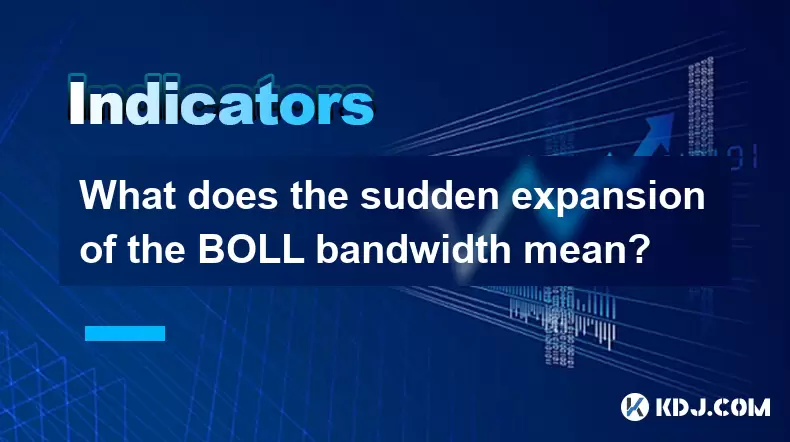
What does the sudden expansion of the BOLL bandwidth mean?
Jun 21,2025 at 01:49pm
Understanding the BOLL IndicatorThe BOLL (Bollinger Bands) indicator is a widely used technical analysis tool in cryptocurrency trading. It consists of three lines: a simple moving average (SMA) in the center, with upper and lower bands calculated based on standard deviations from that SMA. These bands dynamically adjust to price volatility. When trader...

Is the golden cross of the ROC indicator below the zero axis effective?
Jun 20,2025 at 09:42pm
Understanding the ROC Indicator and Its Role in Cryptocurrency TradingThe Rate of Change (ROC) indicator is a momentum oscillator widely used by traders to assess the speed at which cryptocurrency prices are changing. It measures the percentage difference between the current price and the price from a certain number of periods ago. The ROC helps identif...
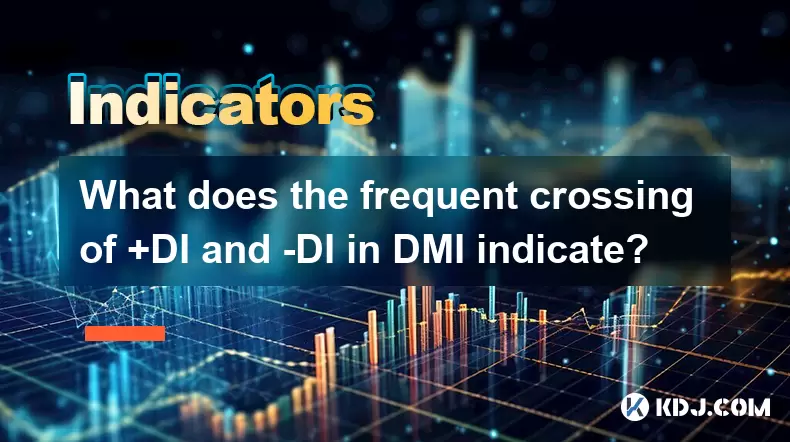
What does the frequent crossing of +DI and -DI in DMI indicate?
Jun 21,2025 at 05:14pm
Understanding the DMI and Its ComponentsThe Directional Movement Index (DMI) is a technical analysis tool used to identify the strength and direction of a trend. It consists of two lines: +DI (Positive Directional Indicator) and -DI (Negative Directional Indicator), along with the ADX (Average Directional Index) line which measures trend strength. In cr...

Does the sudden contraction of ATR indicate the end of the trend?
Jun 20,2025 at 11:14pm
Understanding ATR and Its Role in Technical AnalysisThe Average True Range (ATR) is a technical indicator used to measure market volatility. Developed by J. Welles Wilder, ATR calculates the average range of price movement over a specified period, typically 14 periods. It does not indicate direction—only volatility. Traders use ATR to gauge how much an ...

Is it invalid if the DMI crosses but the ADX does not expand?
Jun 21,2025 at 09:35am
Understanding the DMI and ADX RelationshipIn technical analysis, the Directional Movement Index (DMI) consists of two lines: +DI (Positive Directional Indicator) and -DI (Negative Directional Indicator). These indicators are used to determine the direction of a trend. When +DI crosses above -DI, it is often interpreted as a bullish signal, while the opp...

Is the trend continuation when the Williams indicator is oversold but there is no rebound?
Jun 20,2025 at 11:42pm
Understanding the Williams %R IndicatorThe Williams %R indicator, also known as the Williams Percent Range, is a momentum oscillator used in technical analysis to identify overbought and oversold levels in price movements. It typically ranges from 0 to -100, where values above -20 are considered overbought and values below -80 are considered oversold. T...

What does the sudden expansion of the BOLL bandwidth mean?
Jun 21,2025 at 01:49pm
Understanding the BOLL IndicatorThe BOLL (Bollinger Bands) indicator is a widely used technical analysis tool in cryptocurrency trading. It consists of three lines: a simple moving average (SMA) in the center, with upper and lower bands calculated based on standard deviations from that SMA. These bands dynamically adjust to price volatility. When trader...

Is the golden cross of the ROC indicator below the zero axis effective?
Jun 20,2025 at 09:42pm
Understanding the ROC Indicator and Its Role in Cryptocurrency TradingThe Rate of Change (ROC) indicator is a momentum oscillator widely used by traders to assess the speed at which cryptocurrency prices are changing. It measures the percentage difference between the current price and the price from a certain number of periods ago. The ROC helps identif...

What does the frequent crossing of +DI and -DI in DMI indicate?
Jun 21,2025 at 05:14pm
Understanding the DMI and Its ComponentsThe Directional Movement Index (DMI) is a technical analysis tool used to identify the strength and direction of a trend. It consists of two lines: +DI (Positive Directional Indicator) and -DI (Negative Directional Indicator), along with the ADX (Average Directional Index) line which measures trend strength. In cr...
See all articles























